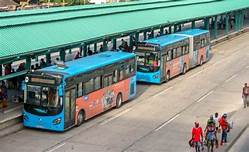BRT Tanzania
With several 100 million dollars in investment, the Dar es Salaam Bus Rapid Transit System (BRT) is an infrastructure that deserves as much awe as any other in the world.
The investment involves some19.3km of roadways traversed by over 100 buses. It has27 bus stations built with such style and elegance they do indeed give the city a facelift so to speak.
More than the aesthetic function, the infrastructure has indeed transformed the port city of Dar Es Salaam from the usual narrow roads dotted with vendors to 6 lanes and pave ways for passengers, it looks good.
The BRT system that was designed by a Brazilian international consulting firm called Logit ferries 1000s of passengers every day and given that its buses run on specialized lanes, they face no traffic and so it takes less time to complete the same routes that regular commuter buses make.
The BRT system is now up and running for several years and all that is left is for the commuters to get used to them, yes ‘get used’. The first issue is the increased traffic lights. Commuters now have to stop where they never did before and they also have to pay attention to traffic lights that were also not there before; so far so good.
Also Read: Tanzania, Uganda finalize Africa’s longest oil pipeline deal
On the lighter side of things, since the buses seemingly don’t travel any faster than regular traffic, averaging 40 km/hr, a lingering query is the question ‘what on earth does the Rapid in BRT stand for?’ Well here is the answer.
Even though the buses travel at the same average speed as the rest of vehicles, they on the other hand operate on specialized lanes. What this means is that there is no congestion on the bus lanes and so while normal traffic only gets few opportunities to reach the average 40Km/hr, the BRT buses can maintain this speed almost throughout their routes.
The buses also have well-spaced drop and pick up stations allowing them to a fluid flow each route and eventually, this adds up to faster transport compared to the old public transport, Daladala, which make random stops, take detours, change routes and take forever looking for passengers at undesignated stops. The buses are also tentatively faster than personal vehicles as well. While you are stuck in the Magomeni traffic trying to get home at 6 Pm the BRT buses cruise by undisturbed.
Now the BRT is expanding, it has moved from the city centre vicinity to the city outskirts of Mbezi Kimara some 25.6 Km away, that is approximately 1 hr away by BRT. That 1 hr, used to be up to 3 to 4 hrs before the BRT.
On the opposite side of the city, the BRT has again expanded to Mwenge and is planned to go onwards to Tegeta another 26Km away. Thanks to the BRT, the look of the city has changed, the speed of getting about the city has dramatically reduced.
With the increased speed of commute, it means residents can live further out from the expensive city centre, to areas that are more accommodating of their incomes. This means a better life for the people.
If you can get better housing further from the city but still make it to work in a good time then you are better off, rather than the congested, expensive city interiors. The city of Dar es Salaam is not only expanding fast but its population is growing exponentially and the city spots some of the world’s fastest population growth rates; ‘the annual growth rate is expected to average 4.39% through the year 2020.’
Also Read: EABC banks on Amb Amina’s WTO nomination to steer bloc’s reforms
Fast Transport, Fast Progress
What is the purpose of investing so much money on city roads? Well, the cities are where the country makes its most revenue, even produce from outside the city is grown for the city and/or must travel through the city en route to the final destination, another city in another country.
So it is no wonder governments chose to put so much money in city infrastructure; put money where there is money to make more money, seems to be the philosophy.
Just how exactly do we define progress? How do we choose between social services and infrastructure, how do we balance our expenditure such that we cater for business and welfare alike ever pushing for the former to contribute to the latter?
The opportunity cost of building a bridge or road is more hospitals and more medicine, it is more desks and textbooks in schools, it is tap water for the 80% living in rural areas and toilets for the city squatters in the city slums. The decision is tough.
In this regard, we tip our hats to the fifth administration for furnishing a budget that prioritizes social welfare and creates more room and support for businesses to operate sustainably contributing to the general wellbeing of the communities in which they serve. That is what we call Fast Transport, Fast Progress.
